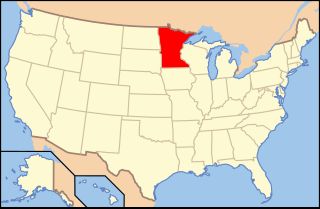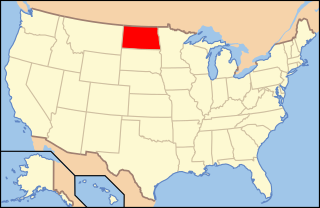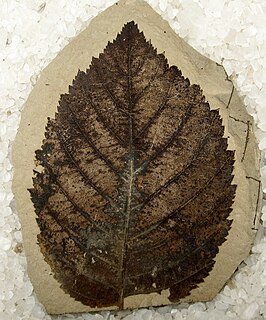
The Hell Creek Formation is an intensively studied division of mostly Upper Cretaceous and some lower Paleocene rocks in North America, named for exposures studied along Hell Creek, near Jordan, Montana. The formation stretches over portions of Montana, North Dakota, South Dakota, and Wyoming. In Montana, the Hell Creek Formation overlies the Fox Hills Formation. The site of Pompeys Pillar National Monument is a small isolated section of the Hell Creek Formation. In 1966, the Hell Creek Fossil Area was designated as a National Natural Landmark by the National Park Service.

Charles Whitney Gilmore was an American paleontologist who gained renown in the early 20th century for his work on vertebrate fossils during his career at the United States National Museum. Gilmore named many dinosaurs in North America and Mongolia, including the Cretaceous sauropod Alamosaurus, Alectrosaurus, Archaeornithomimus, Bactrosaurus, Brachyceratops, Chirostenotes, Mongolosaurus, Parrosaurus, Pinacosaurus, Styracosaurus ovatus and Thescelosaurus.

Archaefructus is an extinct genus of herbaceous aquatic seed plants with three known species. Fossil material assigned to this genus originates from the Yixian Formation in northeastern China, originally dated as late Jurassic but now thought to be approximately 125 million years old, or early Cretaceous in age. Even with its revised age, Archaefructus has been proposed to be one of the earliest known genera of flowering plants.

The Dakota is a sedimentary geologic unit name of formation and group rank in Midwestern North America. The Dakota units are generally composed of sandstones, mudstones, clays, and shales deposited in the Mid-Cretaceous opening of the Western Interior Seaway. The usage of the name Dakota for this particular Albian-Cenomanian strata is exceptionally widespread; from British Columbia and Alberta to Montana and Wisconsin to Colorado and Kansas to Utah and Arizona. It is famous for producing massive colorful rock formations in the Rocky Mountains and the Great Plains of the United States, and for preserving both dinosaur footprints and early deciduous tree leaves.

Florissantia is an extinct genus of flowering plants in the Malvaceae subfamily Sterculioideae known from western North America and far eastern Asia. Flower, fruit, and pollen compression fossils have been found in formations ranging between the Early Eocene through to the Early Oligocene periods. The type species is Florissantia speirii and three additional species are known, Florissantia ashwillii, Florissantia quilchenensis, and Florissantia sikhote-alinensis.

Quillajaceae is a family of flowering plants. It contains only two extant species, Quillaja brasiliensis and Quillaja saponaria, and one fossil species, Dakotanthus cordiformis.

The Raynolds Expedition was a United States Army exploring and mapping expedition intended to map the unexplored territory between Fort Pierre, Dakota Territory and the headwaters of the Yellowstone River. The expedition was led by topographical engineer Captain William F. Raynolds.

Paleontology in Iowa refers to paleontological research occurring within or conducted by people from the U.S. state of Iowa. The paleozoic fossil record of Iowa spans from the Cambrian to Mississippian. During the early Paleozoic Iowa was covered by a shallow sea that would later be home to creatures like brachiopods, bryozoans, cephalopods, corals, fishes, and trilobites. Later in the Paleozoic, this sea left the state, but a new one covered Iowa during the early Mesozoic. As this sea began to withdraw a new subtropical coastal plain environment which was home to duck-billed dinosaurs spread across the state. Later this plain was submerged by the rise of the Western Interior Seaway, where plesiosaurs lived. The early Cenozoic is missing from the local rock record, but during the Ice Age evidence indicates that glaciers entered the state, which was home to mammoths and mastodons.

Paleontology in Minnesota refers to paleontological research occurring within or conducted by people from the U.S. state of Minnesota. The geologic record of Minnesota spans from Precambrian to recent with the exceptions of major gaps including the Silurian period, the interval from the Middle to Upper Devonian to the Cretaceous, and the Cenozoic. During the Precambrian, Minnesota was covered by an ocean where local bacteria ended up forming banded iron formations and stromatolites. During the early part of the Paleozoic era southern Minnesota was covered by a shallow tropical sea that would come to be home to creatures like brachiopods, bryozoans, massive cephalopods, corals, crinoids, graptolites, and trilobites. The sea withdrew from the state during the Silurian, but returned during the Devonian. However, the rest of the Paleozoic is missing from the local rock record. The Triassic is also missing from the local rock record and Jurassic deposits, while present, lack fossils. Another sea entered the state during the Cretaceous period, this one inhabited by creatures like ammonites and sawfish. Duckbilled dinosaurs roamed the land. The Paleogene and Neogene periods of the ensuing Cenozoic era are also missing from the local rock record, but during the Ice Age evidence points to glacial activity in the state. Woolly mammoths, mastodons, and musk oxen inhabited Minnesota at the time. Local Native Americans interpreted such remains as the bones of the water monster Unktehi. They also told myths about thunder birds that may have been based on Ice Age bird fossils. By the early 19th century, the state's fossil had already attracted the attention of formally trained scientists. Early research included the Cretaceous plant discoveries made by Leo Lesquereux.

Paleontology in North Dakota refers to paleontological research occurring within or conducted by people from the U.S. state of North Dakota. During the early Paleozoic era most of North Dakota was covered by a sea home to brachiopods, corals, and fishes. The sea briefly left during the Silurian, but soon returned, until once more starting to withdraw during the Permian. By the Triassic some areas of the state were still under shallow seawater, but others were dry and hot. During the Jurassic subtropical forests covered the state. North Dakota was always at least partially under seawater during the Cretaceous. On land Sequoia grew. Later in the Cenozoic the local seas dried up and were replaced by subtropical swamps. Climate gradually cooled until the Ice Age, when glaciers entered the area and mammoths and mastodons roamed the local woodlands.

The Allenby formation is a sedimentary rock formation in British Columbia which was deposited during the Ypresian stage of the Early Eocene. It consists of conglomerates, sandstones with interbedded shales and coal. The shales contain an abundance of insect, fish and plant fossils known from 1877 and onward, while the Princeton Chert was first indented in the 1950's and is known from anatomically preserved plants.

The Graneros Shale is a geologic formation in the United States identified in the Great Plains as well as New Mexico that dates to the Cenomanian Age of the Cretaceous Period. It is defined as the finely sandy argillaceous or clayey near-shore/marginal-marine shale that lies above the older, non-marine Dakota sand and mud, but below the younger, chalky open-marine shale of the Greenhorn. This definition was made in Colorado by G. K. Gilbert and has been adopted in other states that use Gilbert's division of the Benton's shales into Carlile, Greenhorn, and Graneros. These states include Kansas, Texas, Oklahoma, Nebraska, and New Mexico as well as corners of Minnesota and Iowa. North Dakota, South Dakota, Wyoming, and Montana have somewhat different usages — in particular, north and west of the Black Hills, the same rock and fossil layer is named Belle Fourche Shale.
The Coldwater Beds are a geologic formation of the Okanagan Highlands in British Columbia, Canada. They preserve fossils dating back to the Ypresian stage of the Eocene period, or Wasatchian in the NALMA classification.

Acer chaneyi is an extinct maple species in the family Sapindaceae described from a number of fossil leaves and samaras. The species is known from Oligocene to Miocene sediments exposed in Alaska, Idaho, Nevada, Oregon and Washington in the U.S. It is one of several extinct species belonging to the living section Rubra.

Betula leopoldae is an extinct species of birch in the family Betulaceae. The species is known from fossil leaves, catkins, and inflorescences found in the early Eocene deposits of northern Washington state, United States, and similar aged formations in British Columbia, Canada. The species is placed as basal in Betula, either as a stem group species, or an early divergent species.
Liriodendrites is an extinct genus of plants, known from fossil leaves. These have a forked apex (bifurcate), like those of extant species of Liriodendron. They have been interpreted as transitional between the leaves of the extinct genus Liriophyllum and Liriodendron. The genus has been placed in the family Magnoliaceae. Five species are known: L. aeternus, L. bradacii, L. laramiense, L. occidentalis and L. sachalinensis. It has been discovered in the United States, Egypt and Russia.
Trochodendron rosayi is an extinct species of flowering plant in the family Trochodendraceae. The species is known from fossils found in Middle Miocene deposits of central Oregon. T. rosayi are possibly the fruits belonging to the extinct trochodendraceous leaf species Trochodendron postnastae.

Comptonia columbiana is an extinct species of sweet fern in the flowering plant family Myricaceae. The species is known from fossil leaves found in the early Eocene deposits of central to southern British Columbia, Canada, plus northern Washington state, United States, and, tentatively, the late Eocene of Southern Idaho and Earliest Oligocene of Oregon, United States.

Equisetum similkamense is an extinct horsetail species in the family Equisetaceae described from a group of whole plant fossils including rhizomes, stems, and leaves. The species is known from Ypresian sediments exposed in British Columbia, Canada. It is one of several extinct species placed in the living genus Equisetum.
The Paleoflora of the Eocene Okanagan Highlands includes all plant and fungi fossils preserved in the Eocene Okanagan Highlands Lagerstätten. The highlands are a series of Early Eocene geological formations which span an 1,000 km (620 mi) transect of British Columbia, Canada and Washington state, United States and are known for the diverse and detailed plant fossils which represent an upland temperate ecosystem immediately after the Paleocene-Eocene thermal maximum, and before the increased cooling of the middle and late Eocene to Oligocene. The fossiliferous deposits of the region were noted as early as 1873, with small amounts of systematic work happening in the 1880-90s on British Columbian sites, and 1920-30s for Washington sites. A returned focus and more detailed descriptive work on the Okanagan Highlands sites revived in the 1970's. The noted richness of agricultural plant families in Republic and Princeton floras resulted in the term "Eocene orchards" being used for the paleofloras.















